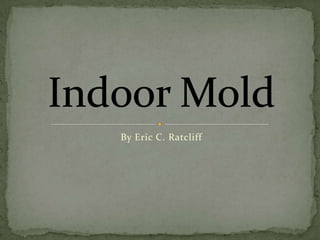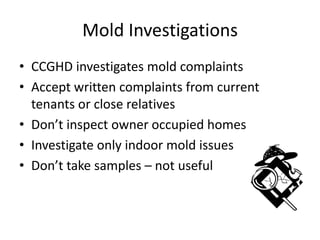Indoor mold
- 1. By Eric C. Ratcliff
- 2. Mold Investigations • CCGHD investigates mold complaints • Accept written complaints from current tenants or close relatives • Don’t inspect owner occupied homes • Investigate only indoor mold issues • Don’t take samples – not useful
- 3. Black Mold • CCGHD interested only in black mold • Recommend removal of other varieties • Mold & mildew are synonymous • An allergen like pollen • No scientific evidence of adverse health effects • Anecdotal evidence of health effects
- 4. Health Effects of Mold • Mainly respiratory – coughing, sneezing, sore throat, runny nose, congestion • Other allergic reactions – headaches, burning eyes, skin rash, etc. • Irritant • Does not cause colds • Can aggravate colds, flu, & Asthma
- 5. Exposure Limits • No exposure limits • Link to health effects not scientifically substantiated • Not known what quantity is acceptable • Sensitivity to mold varies from person to person
- 6. “Toxic Mold” • “Toxic mold” a misnomer • Mold itself isn’t toxic • Produce mycotoxins as a by-product • Toxic only if ingested • Stachybrotrys - “toxic” variety < 1% of mold • CCGHD assumes all black mold is “toxic”
- 7. “Killer Mold” • “Killer mold” - media hype • Began by flawed study in Cleveland • CDC retracted entire study • Misinformation perpetuated by media & lucrative lawsuits
- 8. Mold Problem ? • Sanitarian identifies mold problem visually & by odor • Musty odor, & 10 sq. ft. or more of visible black mold indicates a mold problem
- 9. Mold Removal • < 10 sq. ft. is a small amount • 10 sq. ft. or more is generally the landlord’s responsibility • < 10 sq. ft. - responsibility of the tenant
- 10. Large Amount Small Amount
- 11. Large Amount Small Amount
- 12. Mold Not An Issue • If sanitarian can’t see it or smell it • In wall or ceiling cavity – provided there are no holes • In unfinished attic • In unfinished basement • In garage
- 13. County Requirements • Require removal in occupied rental units • No requirement for removal in vacant units • No requirement for removal in owner occupied dwellings • Will issue NOV to landlord if appropriate
- 14. Outdoor Mold • Not a health nuisance issue • Cannot be controlled • Not regulated • No requirement for removal
- 15. Algae on Buildings • Green color • Algae is not mold • No adverse health effects • No requirement for removal
- 16. Window & Door Frames • Responsibility of tenant to clean windows, window frames, & door frames • Recommend regular cleaning
- 17. Bathroom Fixtures • Tenant’s responsibility to clean bathrooms, & remove mold caused by showering • Also tenant’s responsibility to clean toilets
- 18. Water Stains • Water stains not a violation • Water stains can be confused with mold
- 19. Causes of Indoor Mold • Water leaks • Excessive moisture • Mold needs moisture or water to grow • The key to controlling mold is controlling moisture
- 20. Mold Prevention • Repair leaks such as roof leaks, plumbing leaks, etc. • Direct water away from buildings • Repair downspouts • Clean gutters
- 21. Mold Prevention • Eliminate sources of moisture • Vent clothes dryer properly • Remove water on windowsills • Wipe down shower stall • Use bathroom vent • Purchase dehumidifier
- 22. Mold Prevention • Keep furniture 4” - 6” away from outside wall • Keep interior doors open • Provide adequate ventilation • Maintain adequate heat • Report water leaks to landlord
- 23. Mold Removal Procedure • If you see mold, remove it • Clean affected area w/ detergent & water • Rinse • Sanitize w/ 10% bleach solution • Let dry • Paint or seal if desired
- 24. Personal Protective Equipment (PPE) • Respirator – half face w/ dust cartridges • Gloves – especially when using bleach • Coveralls or long sleeves
- 25. Containment • Not required – mold isn’t asbestos • Doesn’t prevent mold – it’s already present • Keeps other areas clean • Limits exposure
- 26. Moldy Carpet • Should be discarded, along with pad • Mold develops in wet carpet in ~ 6 days • Mold cannot be removed from textiles • Wet carpet should be taken up & dried • At least wet vac carpet
- 27. Other Moldy Items • Professionally clean upholstered furniture • Clean leather w/ saddle soap • Separate books & papers – let dry • Wash & dry fabrics • Discard items
- 28. Mold Remediation Companies • No state certification • Contact BBB • Get 3 estimates & a written contract • Costs $10,000.00 for basement • Save money - use elbow grease
- 29. Professional Mold Inspections • No state certification • Air samples - $300.00 each • Complete air study - $3,000.00+ • Air study includes indoor & outdoor sampling • Establishes relative concentrations
- 30. Mold Test Kits • Available in hardware stores • Various kits available • Not recommended by CCGHD • If you test for mold, you will find it • If you can see it, remove it
- 31. Resource List • www.clermonthealthdistrict.org • www.cdc.gov • www.epa.gov • www.aiha.org
- 32. The End































